If you’re welcoming a miniature dachshund puppy into your home, you may be interested in learning as much as you can about this adorable and popular breed.
Curious about what to expect from your mini dachshund’s progression? In this guide, we’ll help you on the path to becoming an informed, loving, and supportive mini-doxie guardian. Below, we’ll discuss the breed’s history, how big they may grow, the best ways to teach them, what health issues they are at an increased risk of, and more.
Miniature Dachshund: Breed Summary
The mini dachshund’s roots are quite similar to that of the standard-sized dachshund. Both originated in Germany as small, agile, fierce, and adorable hunting dogs. But while the standard dachshund was bred to hunt badgers, breeders created the mini doxie in response to a surge in the rabbit population in Germany in the early 1800s. Their body plan remained much the same as the standards, but their smaller size allowed them to deftly dive into the tight spaces of rabbit burrows.
Today, in Germany, the mini dachshund is still a popular rabbit-hunting dog. In the US, they are more popular as a family pet than a hunting companion. These adorable, goofy, and loving pups consistently rank in the top 10 most popular dog breeds in the US.
Attributes
While it’s important to note that the genetic makeup of your mini doxie isn’t the sole determiner of their behavioral characteristics, research does support that genetics play a role. As importantly, how your pup is raised, their early formative experiences, their health, connection to their primary caregiver, and if their species-specific needs are consistently met also greatly impact behavior and personality.
Given their breed history of hunting small prey in burrows, you may find that your mini dachshund is inclined to chase or even have a prey drive toward small animals. This is not set in stone, and proper socialization and providing safe outlets for a prey drive may help your pup coexist peacefully with smaller household pets.
Because they were bred to dig into burrows to hunt, your mini dachshund pup very well may be inclined to dig. It’s best to offer an acceptable outlet for this behavior, such as providing a digging pit for enrichment.
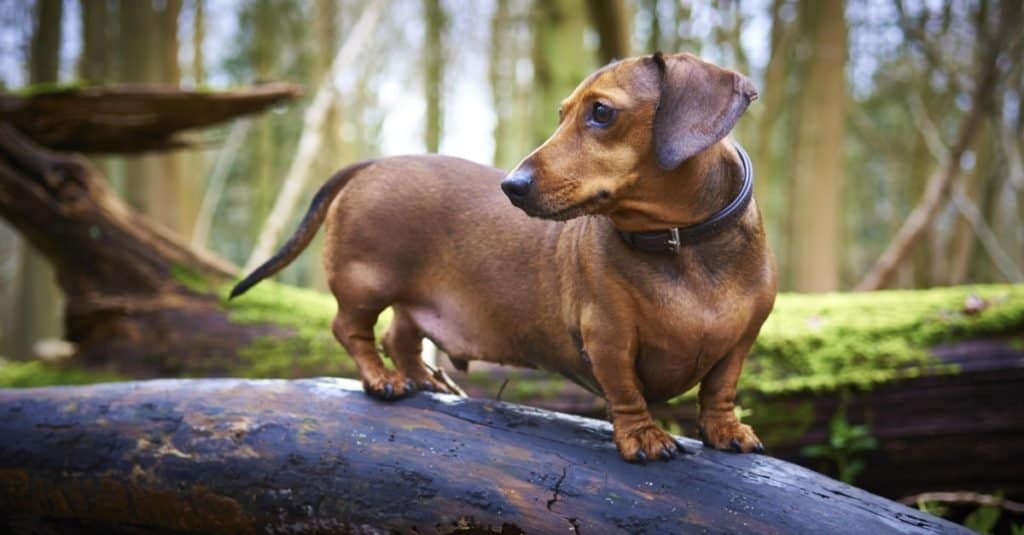
The miniature dachshund was originally bred to hunt rabbits.
©Owen Brown/Shutterstock.com
Mini Dachshund Progression: Growth Chart
Below is a chart detailing average growth milestones for a miniature dachshund, beginning at 8 weeks of age. According to the AKC, there is no notable size distinction between males and females of this breed.
| Age | Miniature Dachshund |
|---|---|
| 2 Months | 2-5 pounds |
| 3 Months | 3-8 pounds |
| 4 Months | 4-9 pounds |
| 5 Months | 5-9.5 pounds |
| 6 Months | 5.5-10 pounds |
| 7 Months | 6-10.5 pounds |
| 8 Months | 7-11 pounds |
| 9 Months | 7-11 pounds |
| 10 Months | 7-11 pounds |
| 11 Months | 7-11 pounds |
| 12 Months | 7-11 pounds |
When Will My Mini Dachshund Stop Growing?
As a small dog, your mini dachshund will reach physical maturity at a much quicker rate than large breed dogs, such as a golden retriever. By about 5 months of age, your pup will already slow down in its growth process. By 8 months of age, your mini doxie may already reach full physical maturity. This doesn’t mean they are fully socially mature at this point, but by 8 months old, they may reach their mature height and weight.
If you want to ensure that your mini dachshund puppy is on track developmentally, it’s best to set up periodic vet checkups as they grow.
Mini Dachshund Progression: How Big Will My Mini Dachshund Be When Fully Grown?
According to the AKC, the accepted size of the miniature dachshund is at or below 11 pounds for both males and females. Generally, healthy adult mini doxies range from 7-11 pounds. They typically stand at 5-6 inches tall at the shoulders.
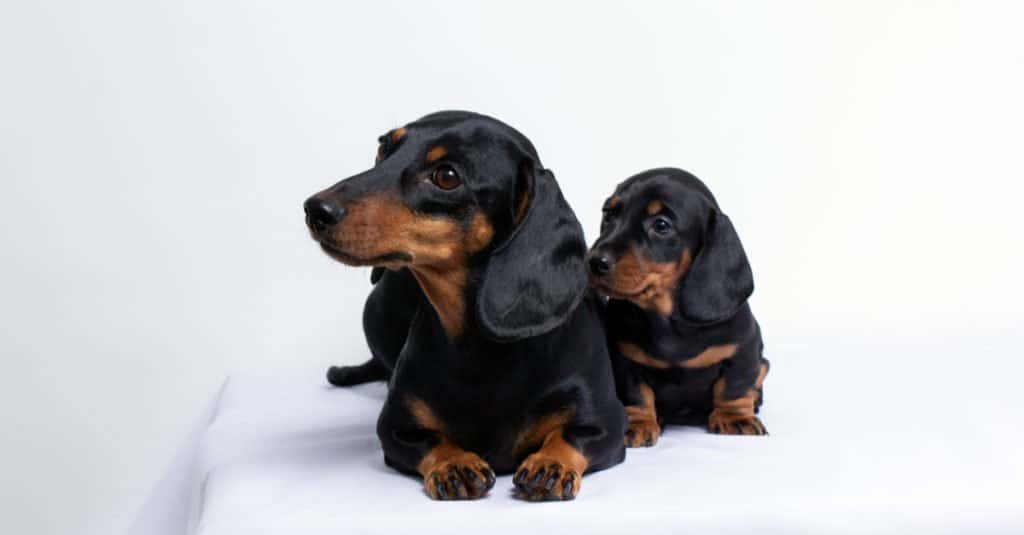
You can expect your miniature dachshund to reach 7-11 pounds at maturity.
©Shedara Weinsberg/Shutterstock.com
When Should My Mini Dachshund Be Spayed or Neutered?
Modern research shows that the question of spaying or neutering is specific to the breed and size of the dog. Altering can have some benefits, such as ensuring you won’t contribute to the overpopulation crisis facing shelters and rescues. Additionally, spayed and neutered dogs have a greatly decreased chance of developing reproductive cancers. However, modern research also shows that altering dogs, especially at under 1 year of age, can create significant health issues, such as developmental joint and bone diseases, urinary incontinence, and increased risks of certain cancers.
So, as you can see, there is no simple, one-size-fits-all answer to this question. As a small breed, mini dachshunds are at less risk than large dogs of developing long-term health problems and certain cancers potentially linked to spaying and neutering. However, dachshunds of all size variations face an increased risk of developing canine intervertebral disc disorders from altering.
To reduce the risk of your mini dachshund developing an intervertebral disc disorder from early altering, your vet may recommend waiting to spay or neuter your pup until 18-24 months of age.
Mini Dachshund Progression: When Should I Potty Train?
You can begin potty training your mini dachshund puppy at 8 weeks old. The amount of time your puppy can wait between eliminations depends on their age. The general rule of thumb is that young puppies can hold it for one hour for every month of age. So, a 2-month-old mini doxie can typically only wait 2 hours between eliminations. Taking them out before this 2-hour mark will greatly increase your chances of helping them learn.
The best way to potty train is to use consistency, kindness, and patience. It’s important to form positive associations with your pup eliminating in the right places. Offer plenty of snuggles, play, and treats after they go to the bathroom in the appropriate places.
Don’t Punish Accidents
If your mini dachshund puppy has an accident, it’s crucial to not punish or scold them. Using punishment won’t help your puppy learn where you’d like them to go. However, it can easily teach them that you are scared and unsafe to use the bathroom around. As a result, you can damage your relationship and may find that your mini doxies will start hiding where they are eliminated. Additionally, punishment-based training is proven to be damaging.
When Should My Mini Dachshund Stop Eating Puppy Food?
You can begin transitioning your mini dachshund to adult food at about 8-10 months old. Before this time, you’ll want to feed them puppy food with at least 22% protein and 8% fat to support healthy development. When they are actively growing, it’s best to feed them 3-4 times a day. Once you switch them to adult food, you can also start feeding only twice per day, although it’s perfectly fine to continue feeding lunch if you choose.
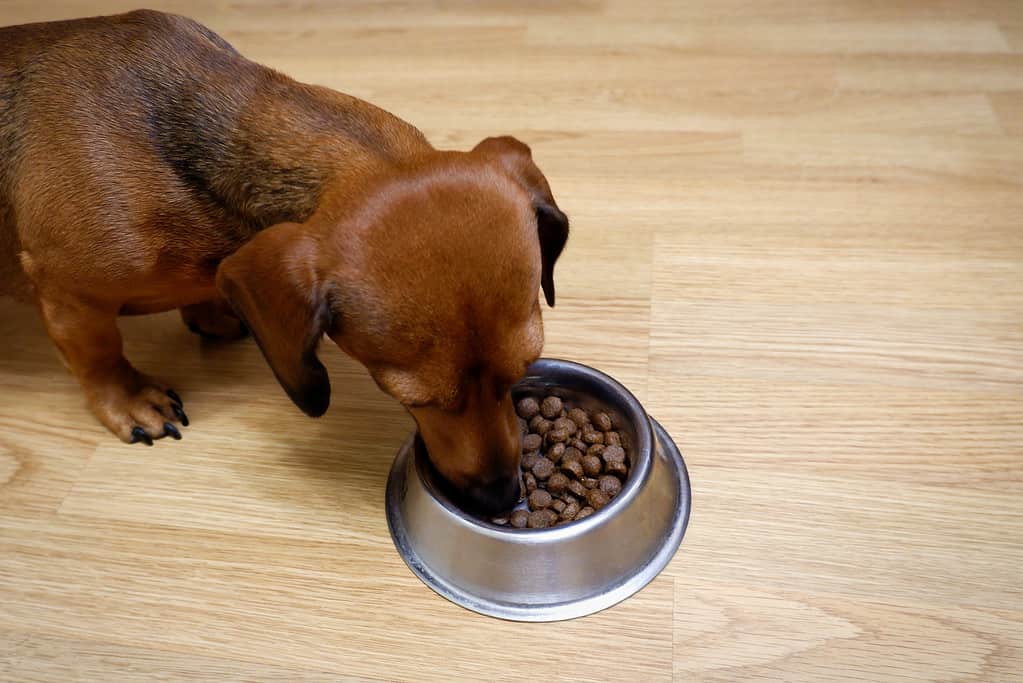
You can begin transitioning your mini dachshund to adult food at about 8-10 months of age.
©Dmitry Andreev/iStock via Getty Images
Mini Dachshund Progression: When Will My Mini Dachshund Start Losing Teeth?
Your mini doxie pup will begin losing their set of 28 baby teeth around 12 weeks of age. At around 6 months of age, your puppy should have their full set of 42 adult teeth.
As the baby teeth fall out and the adult teeth begin erupting from the gums, your mini dachshund puppy will likely seek out items to consistently chew on. During this teething phase, they will find objects to chew to soothe the discomfort of their adult teeth coming in. It’s important to provide them with an array of appropriate objects to chew.
Trade Chewing Items, Don’t Take!
If your mini dachshund is chewing on something inappropriate, it’s important to not just snatch the item away. Instead, as much as possible, you’ll want to trade them. By offering an equally good or better item for your puppy to chew, you are showing them that you’re someone they can trust and offer items to. If you only take things away from them, your mini-doxie may develop habitual resource-guarding behaviors and become distrustful of you.
When Should I Start Training My Mini Dachshund?
At about 8 weeks of age, you can start short, fun, and rewarding education sessions with your puppy. These sessions must be positive reinforcement-based and centered on nurturing a strong, supportive bond between you and your puppy. By using positive reinforcement and relationship-based training, you can ensure that your puppy is excited and happy to learn.
The use of positive reinforcement helps motivate your mini doxie to repeat a desired behavior by giving them something they find truly rewarding. For dogs, these positive reinforcers typically include treats, toys, play, and snuggles.
It’s important to note that training is often overemphasized, especially during the first few weeks of a puppy being brought home. Most puppy parents feel like they need to immediately begin a training regimen or their puppy will fall behind in life. However, developing and fostering a secure attachment bond, socializing, and helping your puppy feel safe in processing novel environments are crucial components often underemphasized in comparison to training sessions.
Your puppy may know how to sit or lay down on cue, but if they don’t feel safe in novel environments, you may find that they become increasingly anxious and defensive, especially in their adult life. Helping them feel safe while processing the world when they are young is hugely important to the development of a well-rounded, confident adult.
The Early Socialization Period
Between the age of 3-12 weeks, your miniature dachshund puppy is in their early socialization period. During this critical time in their development, their brain is primed to process and learn about new experiences. Especially during this time, you’ll want to make sure that your mini doxie has consistently positive novel experiences. A general rule of thumb is to try to introduce them to one new thing every day. This includes a novel sight, sound, smell, taste, tactile experience, and social interaction. Make sure to keep these novel experiences positive. You don’t want to force them into situations that scare your puppy and cause them to shut down. Instead, move at their pace while gently encouraging your pup to explore the world around them.
For your mini dachshund, it’s especially important to introduce them to small animals at a very early age. You’ll want to prioritize teaching them to gently interact with other common household pets, such as rabbits and kittens. Again, make sure to only use ethical, force-free methods.
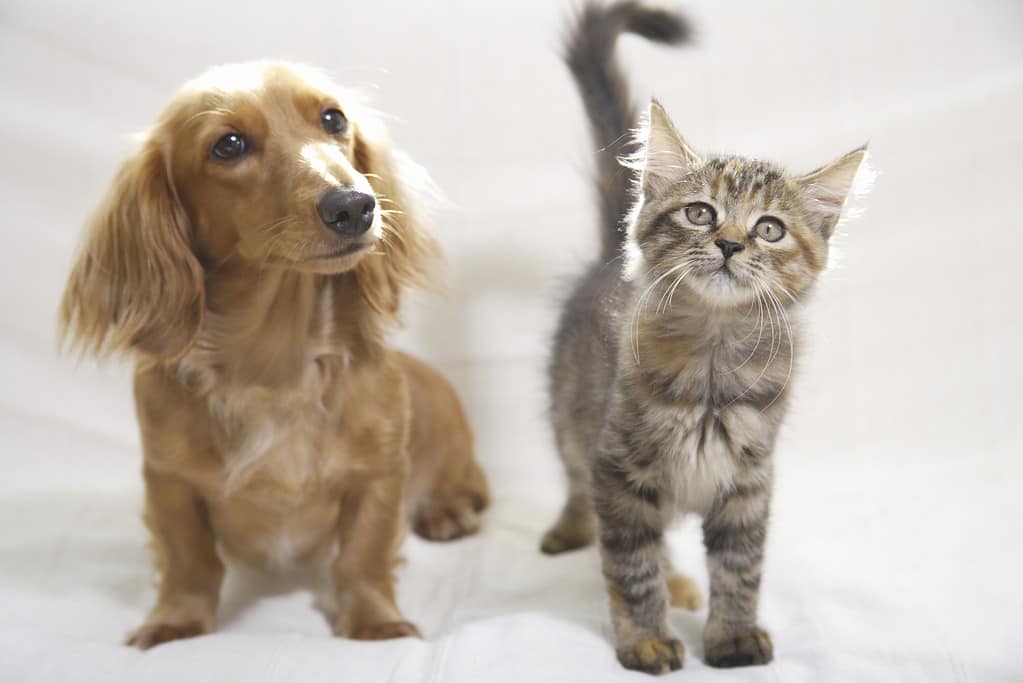
Prioritizing socialization with your miniature dachshund puppy can help ensure they socialize gently with other small animals.
©gyro/iStock via Getty Images
Mini Dachshund Progression: What Cues Should I Teach First?
Training sessions for your mini dachshund should prioritize helping them safely navigate our human-dominated world. One of the best cues you can begin teaching a young puppy to help strengthen your bond and keep them safe is a recall cue. Especially for a hunting breed like the mini doxie you might be interested in roaming or chasing a squirrel, it’s important to facilitate a relationship in which they feel highly motivated to return to you when called.
To begin this with a young puppy, simply take a few steps away from your mini dachshund. Next, encourage them to come to you using a happy tone. You can also show them a treat or toy. As they head towards you, immediately offer the treat/toy and give lots of praise and snuggles. Slowly, you can increase distance and how distractable the environment is. You can also add in your recall word.
Teaching “Wait”
Since dachshunds can be quite enthusiastic about exploring their environment, you can also begin teaching a waiting cue to make sure your pup doesn’t dash out the door or cross the street before you’re ready. Like the recall cue, it’s important to start with short, highly achievable sessions.
You can begin teaching this cue in several ways. One way is to work with your front door. Start by bringing your mini doxie on a leash to the front door. Say “wait” in a calm, cheerful tone, and open the door with a tiny crack. If your pup stays still, say “good”, “yes” or whatever word you’d like to use to mark the behavior, and then quickly give them a treat. Make sure to only wait one second before marking the behavior and giving a reward. You’ll need to build up the duration of time that you ask your puppy to wait.
If your puppy is having a difficult time staying still while you open the door a tiny bit, then take a step back and ask them to stay still while you’re reaching for the handle, then mark and offer a treat for this behavior. Slowly increase the amount you can open the door while your mini dachshund waits for you to encourage them to move forward with you.
Common Health Issues Your Mini Dachshund Might Experience
There are a few genetic health issues these cute pups are more prone to developing. Particularly as they age, miniature doxies are at an increased risk of developing eye issues, such as cataracts and glaucoma. They are also more likely to develop periodontal diseases and rapid tooth decay. As such, it’s especially important to provide consistent dental hygiene for your mini doxie.
Finally, all dachshund varieties have an approximately 10-12 times higher risk of developing intervertebral disc disorders than other breeds. Increasingly, animal welfare organizations and veterinary associations are related to breeding dogs with extreme, long, and low body plans.
If you notice any sudden behavioral shifts in your mini dachshund, it’s important to consider whether an underlying medical condition may be involved. These sudden changes can include appetite shifts, gait changes, lethargy, hyperactivity, defensiveness, unusual fear responses, guarding of the body, etc. A vet check is always an excellent idea in response to new, concerning behaviors exhibited by your pup.
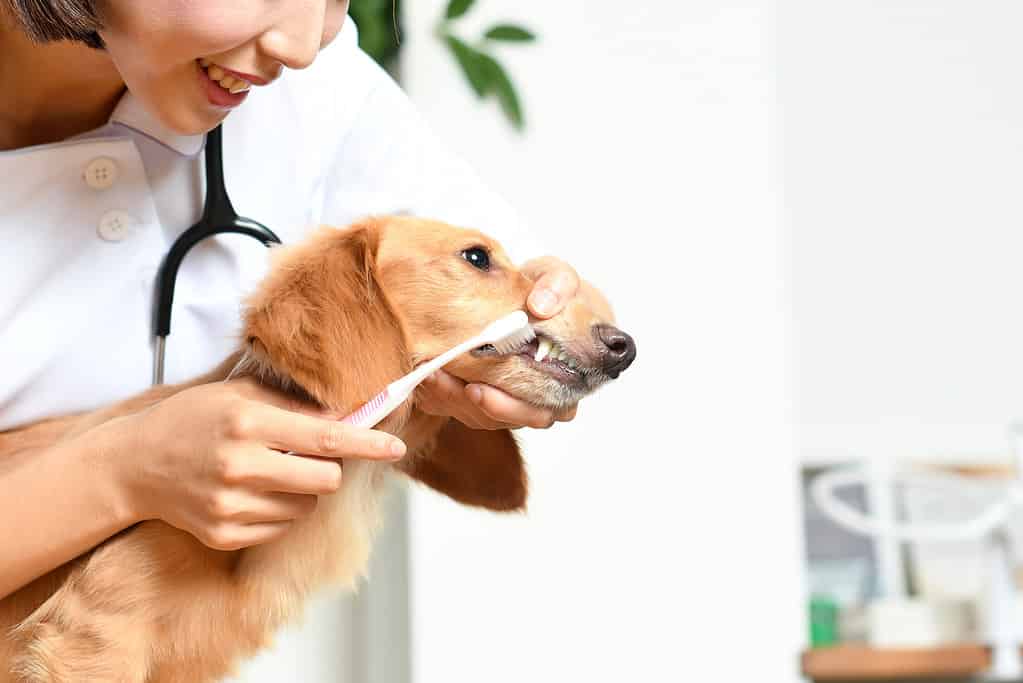
Dachshunds of all sizes are prone to developing dental diseases, so it’s important to provide regular cleanings for your mini dachshund.
©koumaru/iStock via Getty Images
Picture of a Miniature Dachshund Puppy
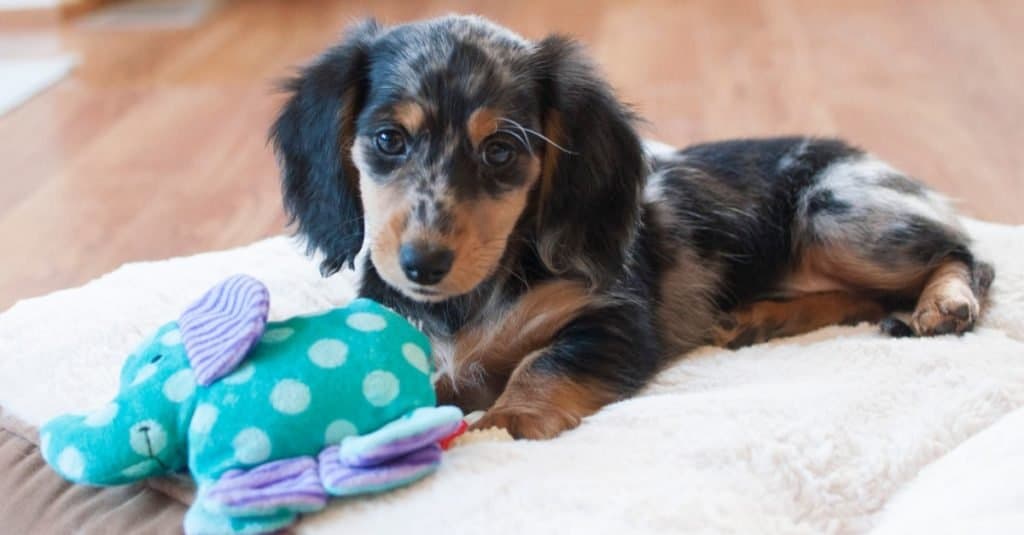
An adorable miniature, long-haired, dapple dachshund puppy.
©Carolyn Dietrich/Shutterstock.com
Picture of a 6-Month-Old Miniature Dachshund

A lovely, long-haired, 6-month-old miniature dachshund
©gyro/iStock via Getty Images
Picture of an Adult Miniature Dachshund

A curious, short-haired, adult mini dachshund.
©James Player/Shutterstock.com
The photo featured at the top of this post is © Sherri Simms/iStock via Getty Images
Ready to discover the top 10 cutest dog breeds in the entire world?
How about the fastest dogs, the largest dogs and those that are -- quite frankly -- just the kindest dogs on the planet? Each day, AZ Animals sends out lists just like this to our thousands of email subscribers. And the best part? It's FREE. Join today by entering your email below.
Thank you for reading! Have some feedback for us? Contact the AZ Animals editorial team.






